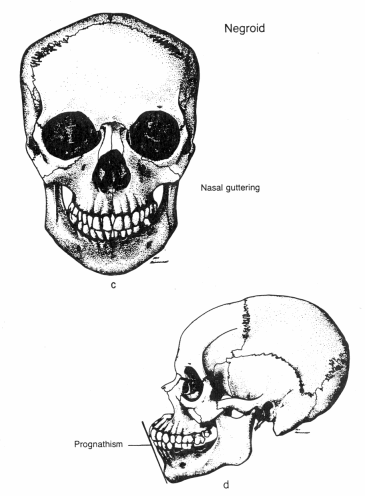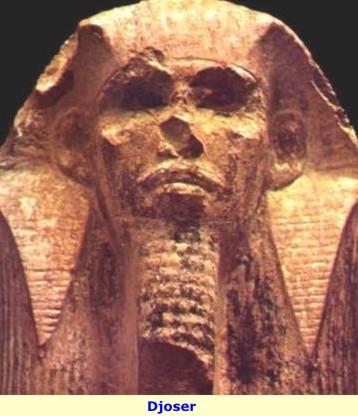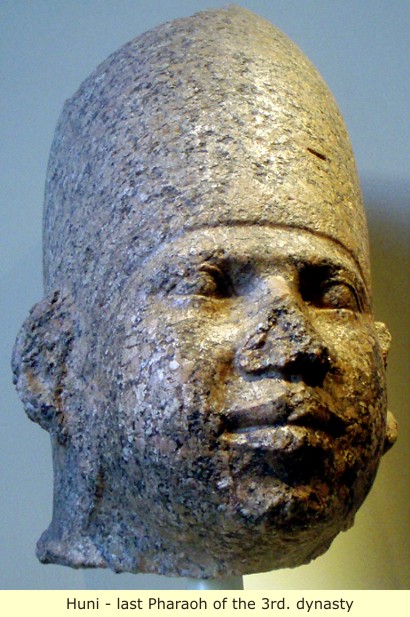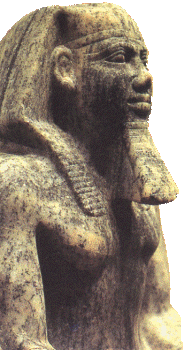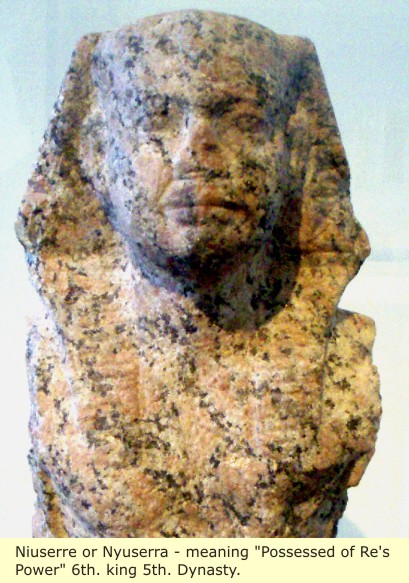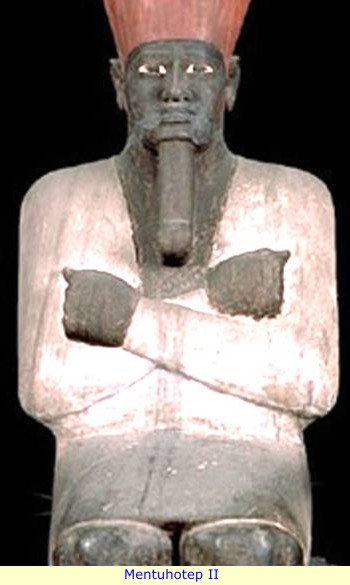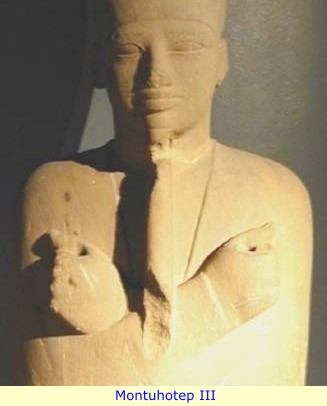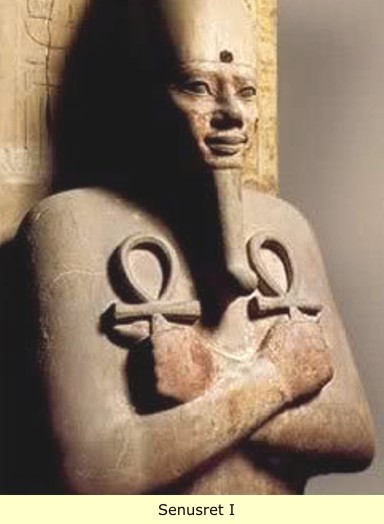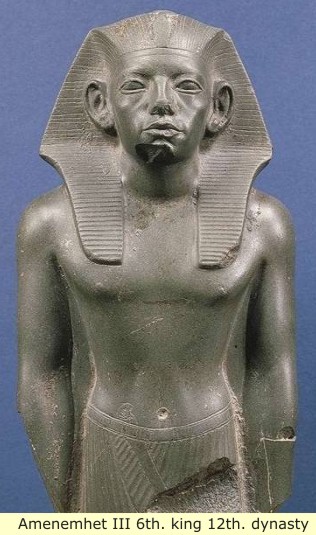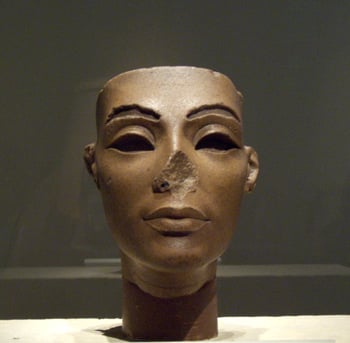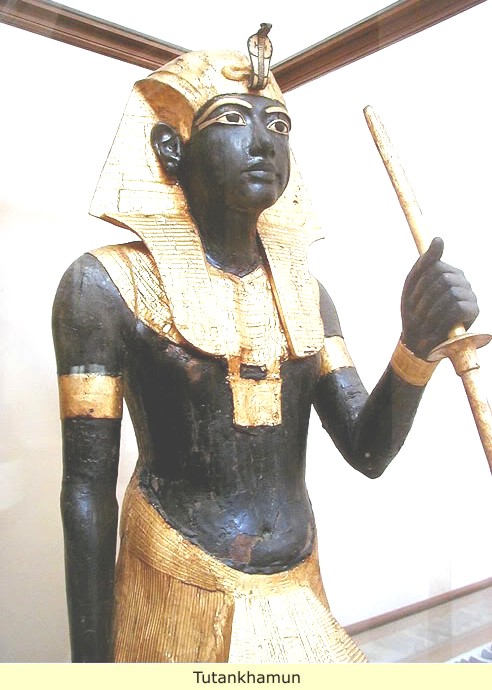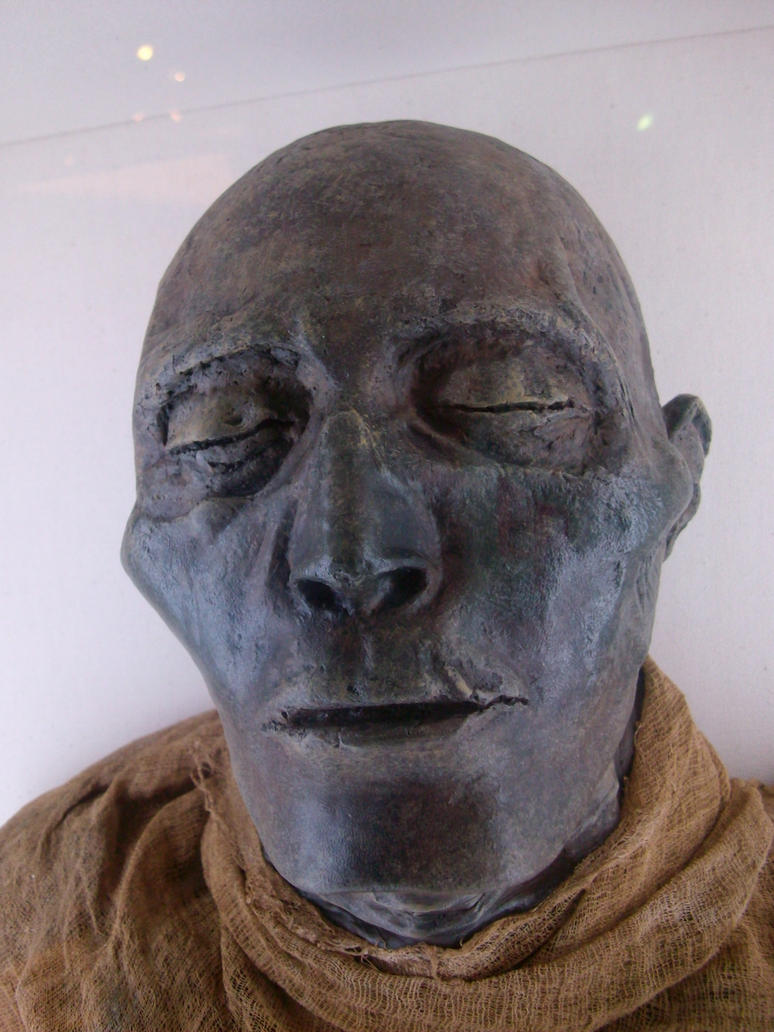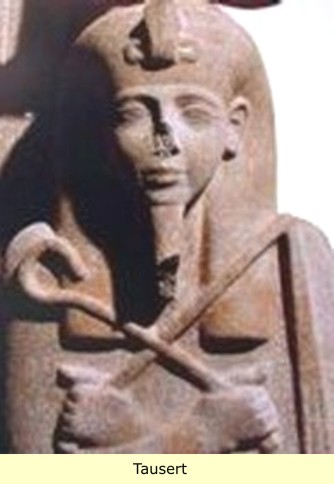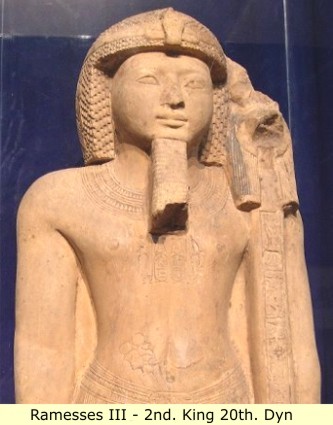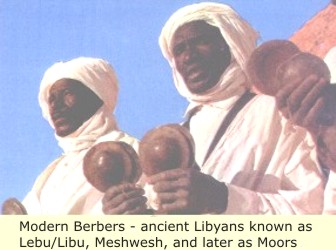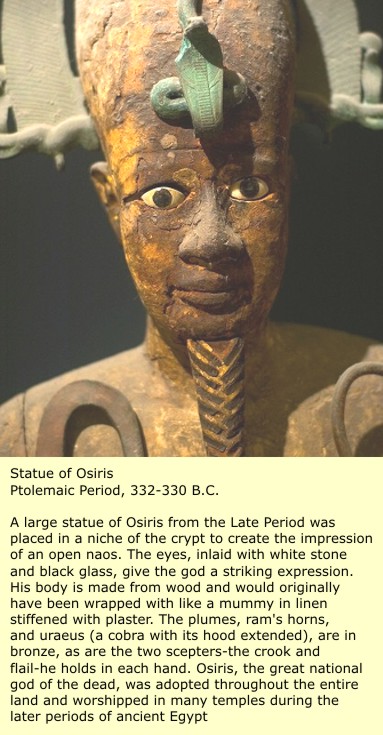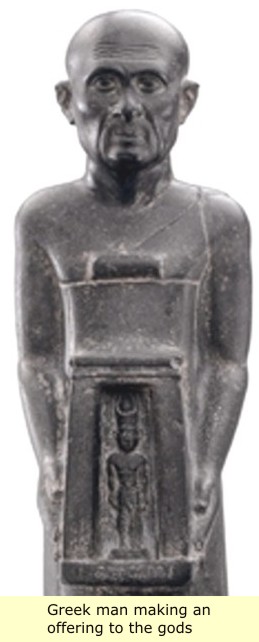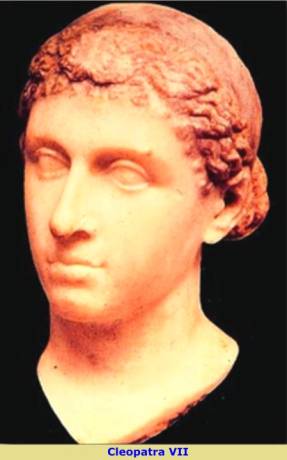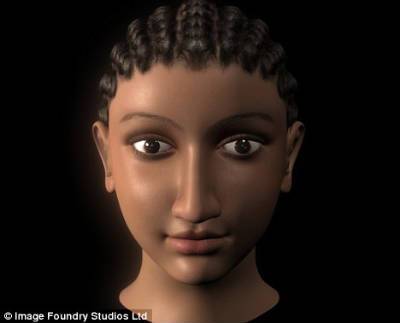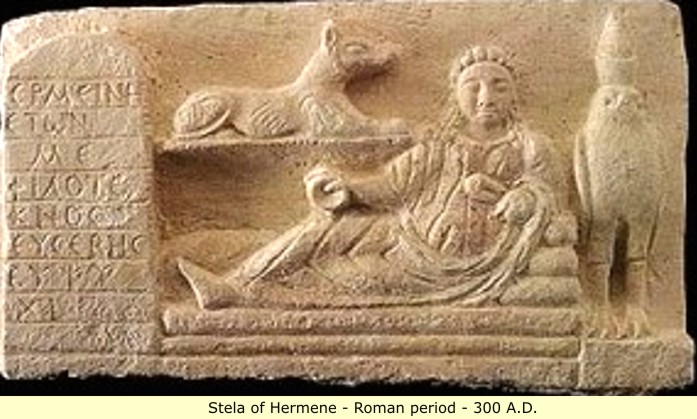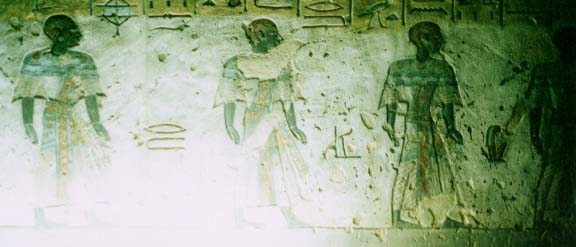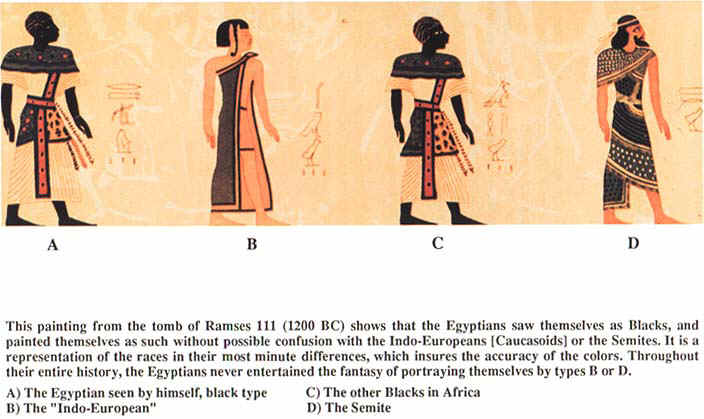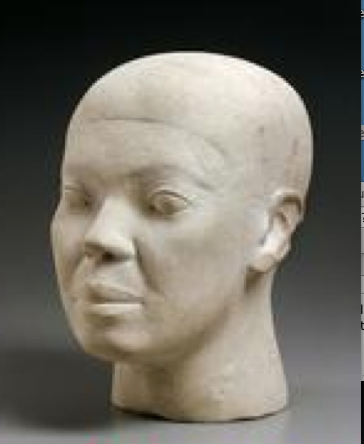The Nubians Pharaohs of the 25th Dynasty (Still Third Intermediate Period
From earliest times, even from the time of unified Egypt's first Pharaoh - Narmer, Egypt's southern neighbor Nubia, {modern Sudan}, had always been treated as Egypt's private preserve for conquest, plunder and looting. The Nubians always rebelled, and always the rebellions were put down, sometimes brutally. This is best attested by the fact that the fortunes of the two countries were always the inverse: when Egypt was strong Nubia was weak, when Nubia was strong Egypt was weak. Yet at the same time, Nubia's culture was pretty much the same as Egypt's, Nubians were valued members of the Egyptian army, Pharaohs had Nubian wives and Nubians were found amongst Egypt's wealthy. One can only guess at the basis for this strange relationship, but surely it was buried in millennia.
Considering this history, the Hyksos king Apepi I, could hardly have been blamed for trying to form an alliance with the Nubians against Egypt when king Kamose began his war against the Hyksos to reunify Egypt. But Nubia refused, and instead, was Egypt's steadfast ally, providing all that was needed for a successful campaign, and together Egypt and Nubia expelled the Hyksos from Egypt.
Now a thousand years later, a similar situation exists, northern Egypt is once again in the hands of foreign kings, and once again, Egypt's salvation lies in the hands of Nubia. This history perhaps explains Nubian King "Piye's", seemingly strong emotional ties with Egypt, which he obviously considered part of his motherland.

Accordingly, Piye decided to step in and fix Egypt's problems. He marched north and subdued almost all the rebellious elements in Egypt. Then after conquering Egypt, Piye simply went home to Nubia, and to our knowledge, never again returned to Egypt. But he did maintain oversight from his capital in Nubia/Kush. Though Piye chose to govern from Kush, his successor "Shabaka", after completing the total reunification of Egypt, chose to rule from the city of Waset in Egypt. Conventionally, there were five Nubian kings of Egypt, they ruled for about sixty years and comprise the 25th dynasty.
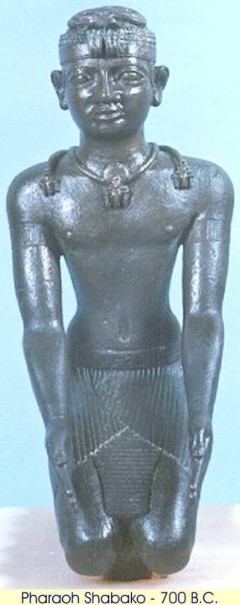


The end of the Nubian 25th dynasty was brought on by two factors: first - the Egyptians had apparently tired of foreign rule, even if it was Nubian. Second - the full-scale invasion of Egypt by the Assyrians. By the time of Nubian king Pi'ankhy, Lower Egypt and part of Middle Egypt had already disintegrated into a number of petty princedoms, which were always ready to side with whichever of the two great powers (Nubia and Assyria), that would be the more likely to leave them with their independence.
The Late PeriodThe Assyrian era of ancient Egypt

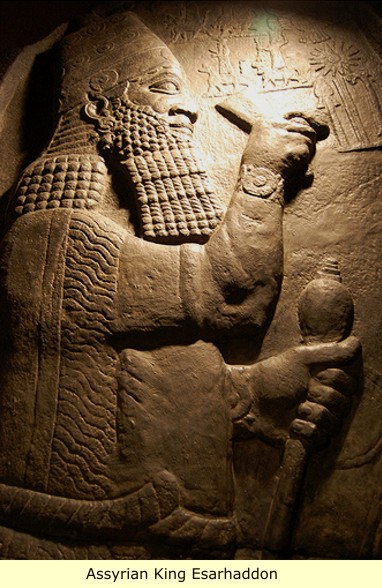
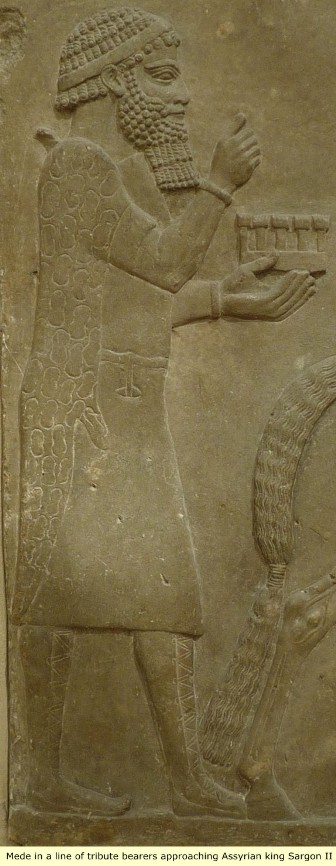
The smoldering hostility of the two great powers flared up afresh under Assyrian king Sennacherib (705-681 B.C.), whose third campaign in Canaan, started with the subjugation of the Phoenician coast-towns.
Trouble had arisen farther south however. The people of the Philistine city of Ekron had expelled their king Padi, on account of his loyalty to Assyria, but Hezekiah of Judah who had received and imprisoned him, became afraid and appealed to Egypt for help. The armies meant at Eltekeh, and a great defeat was inflicted on the Egyptian and Nubian forces.
Padi's throne was restored to him. Many towns of Judah were ravaged, though Jerusalem was not taken. To avoid this, Hezekiah submitted to pay a heavy tribute.
Upon the death of Sennacherib, his son "Esarhaddon" (680-669 B.C.), became Assyria's king. At the beginning of his reign, the Aramaean tribes were still allied with Elam against him, but Urtaku of Elam (675–664 B.C.) signed a peace treaty and freed him from campaigning there. This spelled trouble for Egypt.
In 679 B.C. Esarhaddon stationed a garrison at the Egyptian border, because Egypt, under the Nubian king Taharqa, was planning to intervene in Arum. Esarhaddon then put down, with great severity, a rebellion of the combined forces of Sidon, Tyre, and other Canaanite cities. Now the time was ripe to attack Egypt, which was suffering under the rule of the Nubians and was by no means a united country. Esarhaddon's first attempt in 674–673 B.C. miscarried, in 671 B.C. however, his forces took Memphis, the Egyptian capital. Assyrian consultants were immediately assigned to assist the princes of the provinces, their main duty being the collection of tribute.
The Egyptian records are silent, but stele and tablets inscribed in cuneiform, give circumstantial accounts of the campaign in which Esarhaddon, after subjugating Canaan, drove Nubian king "Taharka" reeling back to the south.
Here is a shortened excerpt from the best preserved of his inscriptions:
From the town of Ishhupri as far as Memphis, a distance of fifteen days, I fought daily, very bloody battles against Tarky, king of Egypt and Nubia, the one accursed by all the great gods. Five times I hit him with the point of my arrows, inflicting wounds, and then I laid siege to Memphis, his royal residence. I destroyed it, tore down its walls, and burnt it down. (After mentioning the booty which he carried off to Assyria he continues): All Nubians I deported from Egypt, leaving not even one to do homage to me. Everywhere in Egypt I appointed new kings, governors, officers, harbor overseers, officials, and administrative personnel.
Esarhaddon reorganized the political structure in the north, establishing Nekau/Necho I (a Libyan) as first king of the 26th dynasty at Sais. Upon Esarhaddon's return to Assyria he erected a victory stele, showing Taharqa's young Prince Ushankhuru in bondage.
Psamtik I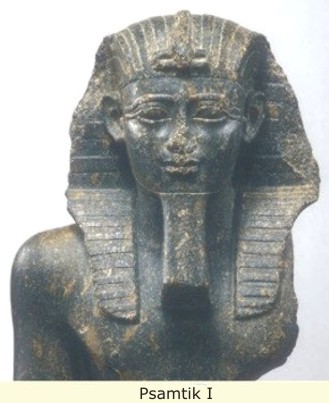
Upon the death of NeKau I (Necho) in 664, Psamtik I was recognized by his Assyrian overlords as King of Egypt, but this was a title at first without substance. He had rule over Memphis and Sais, but mostly the country was controlled by the old guard Egyptians and Libyan princes. He was tasked with the responsibilities of controlling not only the unruly princes and petty kings of the Delta, but also to reconcile with the power center at Thebes. Both Psamtik I, and his father NeKau I (Necho) of Sais, were originally involved with an intrigue associated with the Nubian ruler Taharqo against Assyria, but Psamtik was captured, held and indoctrinated by the Assyrians. Psamtik I was even given the Assyrian name, Nabu-shezibanni, before finally being returned to Egypt, where his father had assumed power in the Delta.
Working with Thebes turned out to be easier then he might have imagined, he was able to align himself with the daughter of a great Theaban nobleman named Mentuemhet. At that time, she held the title, "Adoratice of Amun (God's Wife of Amun). He was able to insert his own daughter Nitokris, as her successor. There can be no doubt, but that political considerations played a part in all this, for after all, Psamtik was himself half a Libyan, and the intense nationalism of the Egyptian natives found appeasement in this way. Moreover, Asiatics and Jews had poured into the country, the latter forming a colony at Elephantine where they were even permitted to build a temple to their god Yahu/ Jehovah. He was therefor able to effect both secular and religious ties that were to hold his growing presence in Egypt together, while he went after his Delta opponents.
In order to do this, he raised a conscript army, as well as employed the services of mercenaries, many of whom were Greek, including Carians. This involvement with foreign mercenaries, raises questions concerning the nature of their presence and their possible control within Egypt. Archaeological evidence suggests that sites such as Naukratis (an exclusively Greek town), among others, were established to facilitate this war, along with offering Egypt an increased commercial presence within the Mediterranean world. From Ramesside times Libyans and other Mediterranean peoples had contributed a substantial part to the armies on which the Egyptian monarchs relied; land had been bestowed upon them in return for their services.
Ahmose II (Amasis)

Ahmose II who was probably the 5th ruler of Egypt during the 26th Dynasty, has been called the last great Egyptian Pharaoh. This is because the rule of his son, Psamtik III, was very short lived, and in fact even in the last days of Ahmose' life, the Persians were already advancing on Egypt. They were the overwhelming power of the region, and would control Egypt up until Alexander the Great 's conquest of Egypt, and the ensuing Greek rulers. After his son “Psamtik III”, never again would an Egyptian rule Egypt, even unto today.
By this late date in Pharaonic history, Wahibres' army was mostly made up of Aegean mercenaries. The two armies met somewhere in the north-west Egyptian Delta in about January or February of 570 B.C, and Apries was forced to retreat. However, this did not give Ahmose complete control of Egypt. Wahibre's apparent retreat was only as far south as Memphis and he continued to control southern Egypt, while Ahmose established himself at Sais in Northern Egypt. Yet Wahibre was not content with this, and aided by his Greek troops, once again marched on Ahmoses’ in October of 570 B.C, where he was once again defeated by his former general. With this defeat, Wahibre could only find safety abroad, and he eventually turned up in the court of Nebuchadnezzar of Babylon. Now Ahmose took control of a united Egypt.
This was complete when sometime between October 19th and December 9th of 570 B.C, Thebes submitted to his reign. Yet poor Wahibre was not yet finished. In March of 567, he again marched on Egypt at the head of a Babylonian army, but once again, Ahmose defeated him, this time capturing the former king. It seems that Ahmose allowed Wahibre to live for a short time, however because we find Herodotus telling us that:
The Egyptians complained that he did wrong by maintaining a man who was the greatest enemy both to them and (Amasis), therefore he delivered Apries to the people, who strangled him.
Apparently, Ahmose still held some respect for his former ruler, because he buried Wahibre with kingly honors in the royal necropolis at Sais. This may very well be explained if indeed Ahmose was married to Wahibres' daughter. However, various sources differ somewhat on these events. Now as the ruler of all Egypt, Ahmose took on the traditional role of builder, and is attested to by quarry inscriptions at Tura and Elephantine and with building projects at Memphis including two granite colossi and a temple of Isis Philae Elephantine, Edfu Sohag, Abydos Koptos, Karnak and any number of Delta sites, including his tomb at Sais. While we have never discovered this tomb, again Herodotus steps in to describe it for us: (It is) a great cloistered building of stone, decorated with pillars carved in the imitation of palm-trees, and other costly ornaments. Within the cloister is a chamber with double doors, and behind the doors stands the sepulchre."
This was really a very prosperous time for Egypt. We are told that agriculture, always the backbone of Egypt, met a spectacular level of success, and Herodotus again tells us that the number of inhabited cities in Egypt reached as high as 20,000. After consolidating his power, Ahmose was apparently somewhat weary of the Greeks, who had been around since the beginning of the Dynasty, and of course, fought against him on the side of Wahibre. Psamtik I had encouraged the Greek merchants in the city of Naukratis, and Ahmose consolidated them in that area only.
This made for easier control of these merchants, and created a lucrative income for the crown in the form of taxes. Prior to Wahibres' defeat, the Greek mercenaries were established in camps between Babastis and the sea on the Pelusiac branch of the Nile, where Herodotus tells us they had remained for over a century. Apparently, he first moved them to Memphis, where he could keep an eye on things. But, Ahmose was not willing to push the Greeks too far because he needed their alliance against the expanding threat of the Persians, as well as an attempted invasion by the Chaldaeans.
Apparently after their unsuccessful invasion, he formed an alliance with the Chaldaeans, Croesus of Lydia, and Sparta. Unfortunately, the Persians destroyed the alliance by first capturing Lydia in 546 and then the Chaldaeans. So instead, he cultivated his relationship with the Aegean world, extending his foreign relationships to include Cyprus. He is said to have even financed the rebuilding of the temple of Apollo at Delphi, after its destruction in 548 B.C. According to archaeological records, he probably even allowed the Greek soldiers to return to their old mercenary camps.
Regrettably, for all his efforts, the Persians would eventually prove too ambitious to stop. By the time of Ahmoses’ death after a long reign of some 44 years, the Persians had long ago conquered Babylon, and were already at the frontiers of Egypt. His son was eventually captured by the Persians, and Herodotus tells us that the Persian ruler Cambyses, had Ahmose's mummy exhumed and:
"subjected to every indignity, such as lashing with whips and the plucking of its hairs, until the executioners were weary. At last, as the corpse had been embalmed and would not fall to pieces under the blows, Cambyses ordered it burnt"
This Marks the end of Egyptian rule in Egypt, Egyptians will never again rule their country, even unto today.
The Persians era of ancient Egypt

When Cyrus II (Cyrus the great), ascended the Persian throne in 559 B.C. He would be like all others – sooner or later – his eyes would turn westward – toward Egypt.
And so it was that Cyrus, by the time of his death in 529 B.C, together with his son Cambyses II, had already completed their plans for a successful assault on Egypt. So after Cyrus had died and Cambyses had become king, Cambyses launched his invasion of Egypt, and it was indeed successful. The Persian kings constitute the 27th dynasty of Egypt.
However over time, dissension at home among the Persians, and various Persian palace intrigues, provided an opportunity for one "Amyrtaios", to take the throne of Egypt. He is believed to have expelled the Persians from the entire country. He was the only ruler of the 28th Dynasty, and he is thought to have been a Libyan, as are all the rest. He ruled Egypt from Sais for six years.
His reign however, was unstable and he was removed from the throne by Nepherites I, who stabilized the country. Nepherites I, thus became the first ruler of the Twenty-ninth Dynasty. Nepherites I, had sent a gift to the Spartans after an allegiance had been entered into with Sparta against Persia. The gift was taken by the Persians after the ships from Egypt were captured as they approached Rhodes. The Egyptians did not know that the Rhodians had defected to the Persians.
The 29th and 30th dynasties are much the same, various obscure rulers, from various places. But since this marks the end of Dynastic Egypt, lets hear from its last kings.

Nectanebo I was the first ruler of the Thirtieth Dynasty and was a general from Sebennytus. He is thought to have been related to the family of Nepherites I. He imposed heavy taxes on the people of Egypt in order to finance Egypt's war with Persia. In the spring of 373 B.C, the Persian army moved in to attack Egypt. They got as far as the Mendesian mouth of the Nile. The two commanders of the Persian forces could not agree on their strategy. As the time passed, the Nile rose and flooded the Delta area, making a march southward impossible. The Persians abandoned their efforts and left. The Egyptians had successfully turned back the Persians, with a little help from the Nile, and peace was reestablished. Nectanebo restored and built many monuments throughout Egypt.

Nectanebo II
360-343 B.C.
Nectanebo II, was the third and final ruler of the Thirtieth Dynasty. He became king after the previous ruler, his uncle "Teo", had campaigned into Phoenicia, which was then a Persian provence, while leaving behind Nectanebo's father Tjahapimu, as governor of the country.
Well, Tjahapimu rebelled, and offered the throne to his son Nectanebo II, who was commanding Teo's troops in Phoenicia, some say Persian money was behind this intrigue. This turn of events left Teos little choice, and he fled to Persia, where he was given refuge, (the Persians felt that a former king would come in handy for the next attack), and Nectanebo returned to Egypt as Pharaoh.
Nectanebo ruled for eighteen years, and built many monuments in Egypt. After the disaster with the Persians, he risked no further expeditions against the Levant states. However, Cyprus and Phoenicia were now fighting against the Persians, and they were assisted by some troops sent by Nectanebo II.
Unfortunately, the Persian King Artaxerxes III, destroyed these troops and then moved against Egypt. Unlike the last Persian attack against Egypt, some thirty years before, this time the Nile flooding had already passed, and the Persian attack was made much more wisely than the last time, (when Nectanebo I was king). The Persian attack was made at three different points at the same time. Defeated, Nectanebo II retreated to Memphis, where he felt that he could make a stand against the Persians. But as city after city fell, all that he could do was gather up, as much of his possessions as he could, and flee to Nubia.
Thus the Persian king, Artaxerxes III, makes Egypt once more a Persian province. Artaxerxes, after taking over all of Egypt, demolished the walls of the most important cities and plundered the shrines, he carried off a vast quantity of silver and gold. He also carried off the written records from the ancient temples, these were later returned to the Egyptian priests, on the payment of huge sums. Then after he had lavishly rewarded the Greeks, who had accompanied him on the campaign, each according to his just deserts, he dismissed them to their native lands. And then, after having installed one "Pherendates" as satrap of Egypt, he returned home with his army.
 Nectanebo II (Still black)
Nectanebo II (Still black)

[Acapella Verse]
I promised Dave I'd never use the phrase "fuck nigga"
He said, "Think about what you saying: 'Fuck niggas'
No better than Samuel on Django
No better than a white man with slave boats"
Sound like I needed some soul searching
My Pops gave me some game in real person
Retraced my steps on what they never taught me
Did my homework fast before government caught me
So I'ma dedicate this one verse to Oprah
On how the infamous, sensitive N-word control us
So many artists gave her an explanation to hold us
Well, this is my explanation straight from Ethiopia
N-E-G-U-S definition:
royalty; King royalty - wait listen
N-E-G-U-S description:
Black emperor, King, ruler, now let me finish
The history books overlook the word and hide it
America tried to make it to a house divided
The homies don't recognize we been using it wrong
So I'ma break it down and put my game in a song
N-E-G-U-S, say it with me
Or say no more. Black stars can come and get me
Take it from Oprah Winfrey, tell her she right on time
Kendrick Lamar, by far, realest Negus alive
